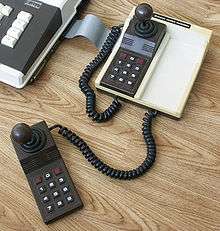Colour Genie
The EACA EG2000 Colour Genie was a computer produced by Hong Kong-based manufacturer EACA and introduced in Germany in August 1982. The company went bankrupt when its founder left it with a suitcase of money. TCS in Germany St, Augustin, near Bonn went bankrupt later. It followed their earlier Video Genie I and II computers and was released around the same time as the business-oriented Video Genie. The BASIC was compatible with the Video Genie I and II and the TRS-80, except for graphic and sound commands; most of the routines for Video Genie I BASIC commands were left over in the Colour Genie's BASIC ROM. Programs were provided to load TRS-80 programs into the Colour Genie. Colour Genie disks could be read in a TRS-80 floppy disk drive and vice versa, editing the pdrive commands.
 EG2000 Colour Genie computer | |
| Manufacturer | EACA |
|---|---|
| Release date | August 1982 |
| Introductory price | £200 (equivalent to £711 in 2019) |
| Operating system | 16 KB ROM containing LEVEL II BASIC |
| CPU | Zilog Z80, 2 MHz |
| Memory | 16 KB RAM, expandable to 32 KB |
| Input | 63-key typewriter style Keyboard with 4 programmable function keys |
| Power | 5V DC, +12V DC and -12V DC |
| Predecessor | Video Genie |
The original Video Genies had been based upon (and broadly compatible with) the then-current TRS-80 Model I. As the Colour Genie was descended from this architecture, it was incompatible with Tandy's newer TRS-80 Color Computer which - despite its name - was an entirely new and unrelated design based on an entirely different CPU, and thus incompatible with the TRS-80 Model I and derivatives such as the Color Genie.
A 80 column card was produced. The Colour Genie was sold by Schmittke Electronics in Aachen, near the dutch and Belgian border were later was Vobis, which sold the Commodore 2000. In Aachen as Vobis reperatur service.

Technical specifications
Central Processing Unit
NEC D780 (Zilog Z80 copy made under licence) running at 2.2 Mhz
Internal hardware
- Video Hardware
- Motorola 6845 CRTC
- 40×24 text (original ROMs) or 40×25 text (upgraded ROMs), 16 colours, 128 user defined characters
- 160×96 graphics (original ROMs) or 160×102 graphics (upgraded ROMs), 4 colours x up to 4 pages
- Sound Hardware
- General Instruments AY-3-8910
- 3 sound channels, ADSR programmable
- 1 noise channel
- 2 8-bit wide I/O ports
I/O ports and power supply
- I/O ports:
- Composite video out and audio out (cinch plugs)
- Integrated RF modulator antenna output, which also carries sound, to TV
- Cartridge expansion slot (slot for edge connector with Z80 CPU address/data bus lines and control signals, as well as GND and voltage pins; used for ROM cartridges or the floppy disk controller
- 1200 baud tape interface (5 pin DIN)
- RS-232 port (5 pin DIN)
- Lightpen port (5 pin DIN)
- Parallel port for printer or joystick controller
External hardware options

- Floppy disk controller with floppy disk station.
- Supported up to 4 drives (5.25 inch).
- Support for 90 KB SS/SD up to 720 KB DS/DD drives.
- Cassette recorder
- EPROM cartridge of 12 KB
- EG2013 Joystick Controller
- 2 Analogue joysticks with keypad
External links
- Colour Genie Homepage (in German)
- Colour Genie games at Everygamegoing Complete list of German and English games for the Colour Genie
- gansweith.freehostia.com/colourgenie/cgenie_en.html Colour Genie Homepage (English Version)
- Colour Genie and information on other EACA machines (English)
- Colour Genie game and review database (English/German)
| Wikimedia Commons has media related to Colour Genie. |